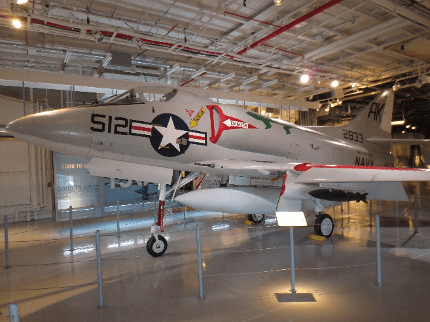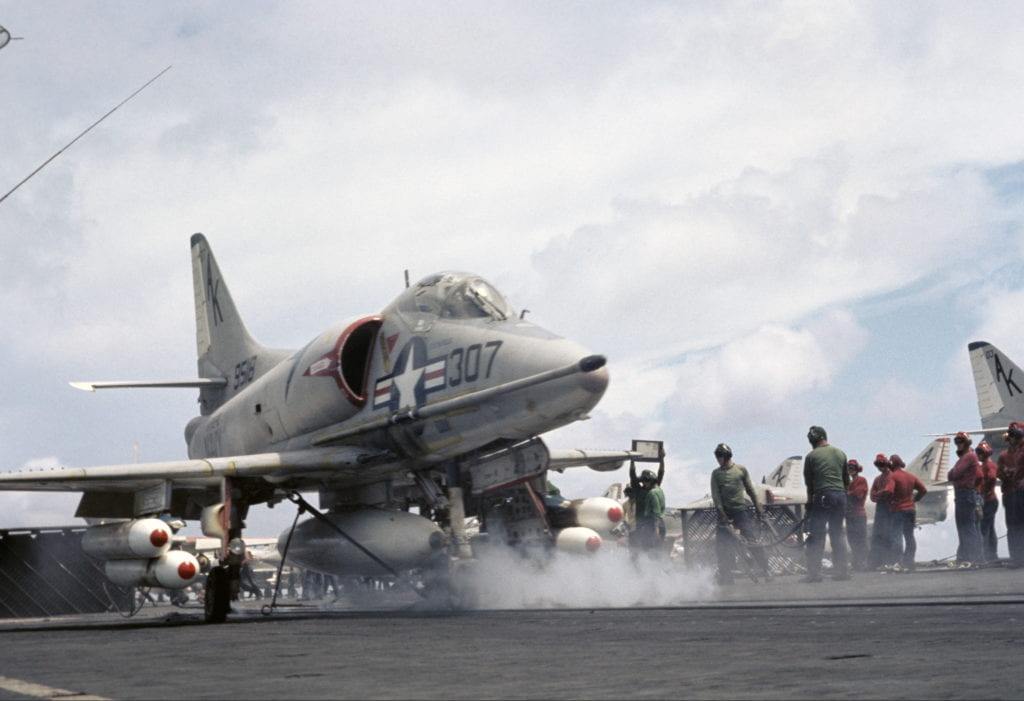430. Douglas A-4 Skyhawk
On this page:
Location: Hangar Deck/Hangar 3

Fast Facts
The A-4 Skyhawk played a pivotal role in U.S. Naval aviation history during the Vietnam War (1955-1975). The A-4B Skyhawk displayed here was restored to its original appearance, as it looked when it flew with attack squadron VA-95 during Intrepid’s first deployment to Vietnam in 1966.

Exhibit Description
In 1966 Intrepid was back at war, this time in Vietnam. Aircraft like this Douglas A-4 Skyhawk flew off Intrepid on many combat missions. This plane was part of Attack Squadron ninety-five. You can tell because the squadrons mascot, a long green lizard, is painted high up on the fuselage on both sides. The jet is pale gray, almost white, with red decorative accents at various spots on the body. The A-4 was a single seat jet. It was designed to be small and light. Its forty feet long and its wingspan is only twenty-seven feet. The A-4 was so compact that it did not need foldable wings, the way most airplanes on carriers did. That’s because it has short delta wings. Most wings stick straight out, like if you hold your arms out horizontally from your body. But a delta wing is shaped like a triangle when viewed from above. The front edge of the wing sweeps sharply back from the fuselage. Like if you point your arms behind you. Attached to the right side of the aircrafts nose is a long pole with a red end. It sticks out a few feet from the jets nose and was used for refueling in the air. Under the belly is a white thing that looks like a bomb. But it’s actually an auxiliary fuel tank. The pilot could drop it when it was empty.
The late Senator John McCain was a Skyhawk pilot. In fact, this is the kind of plane he was flying, off another carrier, when he was hit by surface to air missiles and had to eject out or parachute over North Vietnam. He spent the next five and a half years as a prisoner of war.
You’ll never talk to a pilot that flew an A-4 that won’t tell you it was his best airplane that they ever flew. It was very rugged, very dependable, very capable.
Photos & Videos
Video description: Curator of Aviation Eric Boehm does a walk-around tour pointing out key features of the Museum’s Vietnam War veteran A-4 Skyhawk jet-attack aircraft. Historical images from the Museum’s archives are used throughout to further illustrate important details.


More information
In the early 1950s, the U.S. Navy wanted a jet-powered replacement for the large, piston-engine AD-1 Skyraider. Noted aircraft designer Edward Henry “Ed” Heinemann led his team at Douglas Aircraft Company in creating the versatile A-4 Skyhawk.
The Skyhawk’s key feature is its small delta-shaped wing. With a span of only 27.5 feet (8.4 m), the wings did not require folding for hangar deck storage. By eliminating heavy and complex wing-folding mechanisms, the wings saved weight. All ordnance, as well as extra fuel, was carried externally on racks under the wings and central fuselage. The Skyhawk could also be configured as a “buddy tanker” with extra fuel tanks and a central pod that contained a retractable hose system for refueling other aircraft in flight.
Seven different squadrons flew Skyhawks from Intrepid during three combat deployments to Vietnam between 1966 and 1969. Typical missions for the Skyhawk included lightly armed surveillance and heavily loaded strikes on strategic targets. Some large strikes on high-priority targets, called alpha strikes, included aircraft from multiple aircraft carriers, flown in coordination with U.S. Air Force bombers. On these missions, some of the Skyhawks served as flak suppressors, attacking the anti-aircraft emplacements around the primary target rather than the target itself.
The A-4B Skyhawk displayed here was restored to its original appearance, as it looked when it flew with attack squadron VA-95 during Intrepid’s first deployment to Vietnam in 1966.
This aircraft is on loan from the National Museum of Naval Aviation in Pensacola, Florida.
Statistics
| Length: | 39 feet 4 inches (11.9 m) |
| Wingspan: | 27 feet 6 inches (8.3 m) |
| Height: | 15 feet (4.5 m) |
| Empty Weight: | 9,853 pounds (4,469 kg) |
| Max Weight: | 18,300 pounds (8,300 kg) |
| Top Speed: | 675 miles per hour (1,086 kph) |
| Ceiling: | 47,900 feet (14,599 m) |
| Crew: | One |
| Armament: | Two 20mm Colt Mk 12 cannons, 100 rounds per gun 10,000 pounds (4,535 kg) of bombs, rocket pods, fuel tanks and missiles |